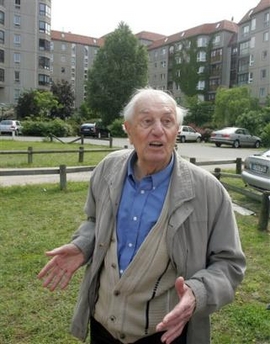At last, a plaque marks site of Hitler's bunker
At last, a plaque marks site of Hitler's bunker
At last, a plaque marks site of Hitler's bunker
For decades, tourists have asked hapless Berliners for directions to Adolf Hitler's bunker; now, at long last, a plaque marks the site.
Just 200m away from Germany's memorial to the Jewish victims of the Holocaust, the sign gives details (in both German and English) of the layout and construction of the grisly subterranean labyrinth where the Nazi fuhrer took his life at the end of World War II.
Previously, Berlin had resisted giving an indication as to the location of the bunker for fear that it could become a symbolic gathering point for neo-Nazi groups.
The result was that some bizarre myths were spawned about the bunker - people claimed
the structure it had a dozen levels and that an underground railway line may have enabled Hitler to escape at the last minute.
There were myths, embellished by Hollywood movies, depicting the bunker as being a lavish subterranean palace complete with a banquet hall and cinema.
Rochus Misch, a German Wehrmacht sergeant who was the SS telephonist in the bunker, is one of the last surviving members of the entourage that was ensconced with Hitler in the bunker in early 1945.
Now 88, he knows the mundane truth about the place and is eager to dispel the myths in frequent interviews.
"Too many myths were allowed to grow up about it - that it was a multi-storey shelter, that it was capable of holding hundreds of people," he says.
"In fact, it was small and cramped and dingy and smelled of blocked toilets and diesel fumes from the generator."
But in some ways, the truth is even more poignantly chilling than all those far-fetched myths. Thanks to the new plaque, visitors see th
at Hitler's chancellery faced onto the freight entrance of a large Jewish-owned department store.
Visitors also see that Hitler had a view from the French doors of his office out onto Brandenburg Gate, the US Embassy and a garden where the children of Propaganda Minister Joseph Goebbels liked to play and where the Holocaust Monument now stands.
The bunker site is best found by tourists by starting at Brandenburg Gate and walking south along the street where the a new American embassy is now under construction.
Immediately beyond the embassy is the Holocaust Monument, built over the back garden of a villa which was once the home of a Prussian nobleman and later the official residence of Weimar Republic President Paul von Hindenburg in the 1920s.
In the Third Reich, it was the in-town home of Joseph and Magda Goebbels and their six children, all of whom were poisoned by Magda in their cramped bunks in the bunker as Red Army troops advanced on Hitler's hideout.
The bunker was
part of Hitler's New Chancellery complex.
It was an enormous building which filled the entire block just south of what is now the Holocaust Monument - and which overlooked the back entrance on Voss Strasse of the Jewish-owned Hertie department store in the 1930s.
As so often, the truth is even more bizarre than the myths.
The poignancy is chillingly real for visitors who stand at the site today, located in the car parking lot of an eight-storey 1980s Communist-era, pre-fabricated, apartment building.
Visitors stand very nearly on the spot where Eva Braun used to sneak upstairs into the open air to have a cigarette between bombing raids, looking out over the garden towardthe s Brandenburg Gate.
In dry, factual terms, the plaque explains the history of the shelter, from the construction over a period of years during the war to its present status as a car park.
But tourists must not expect to see much of the bunker itself: it was blown up in December 1947 by Soviet tro
ops, destroying much of the interior.
The surrounding area was razed around 1960 to deter East Berliners from fleeing to the West and later became part of the east Berlin border zone when the Berlin Wall was constructed in 1961.
In the 1980s, when the East German government constructed a series of bland apartment blocks on the site, the bunker's roof was removed and the interior filled with sand and gravel and turned into a car park.
The precise location had been a state secret during the war and afterwards governments in East and West Germany were wary of drawing attention to the location.
Despite the avid interest of tourists who frequently asked embarrassed shopkeepers about the location of the bunker, Berlin had refused to mark the site for fear it would become a shrine for neo-Nazis.
But the private organisation "Berliner Unterwelten" (Berlin Underworlds), which offers tours of the city's many other underground bunkers, won permission from the urban development author
ity and the state memorial office to put up the sign after years of lobbying.
Berliner Unterwelten chairman Dietmar Arnold said the sober, factual description of the bunker on the panel was meant to rob it of the mythical power it had in the city while it was hidden.
"We wanted to demystify the site," Arnold said.
For Rochus Misch, the one-time telephone receptionist who has become the last living eyewitness to the events which transpired in the bunker, the new plaque is a welcome step toward putting 21st-century visitors in touch with the horrors of the last century in a realistic way.
"I was there," he says. "I know how horrible it all really was.
"People need to know what it was really like. The interest has never waned and I get hundreds of letters a month from people all over the world asking what it was like.
"I won't be here much longer, but the plaque will help to tell the facts as they were."

